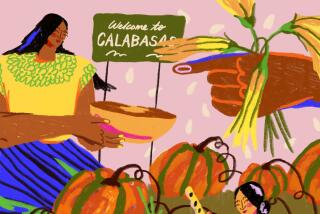Middle East Used Wheat : Corn Slowed Civilization in Mexico, Botanist Says
- Share via
WASHINGTON — Civilization got off to a slow start in Mexico, lagging about 5,000 years behind civilization in the fertile crescent of the Middle East. A University of Wisconsin professor of botany thinks the delay can be blamed on differences in plants.
Speaking at a recent international symposium, Hugh Iltis said New World civilization developed slowly because the basic food crop first cultivated in Mexico was corn.
He said the process of deriving corn from wild plants was “maybe 50 times more complex” than the development of wheat and other crops in the Middle East.
Iltis said agriculture in the Old World started 10,000 years ago with the sowing and reaping of wild plant seeds. Over the years, farmers selected grains with seed pods that didn’t shatter and that could be easily gathered and stored.
Lessons From Animals
He said the early Old World farmers may have taken a few agricultural lessons from golden hamsters and other seed-gathering mammals that lived in the area, learning to hoard seeds over the winter.
“They may even have dug out some of the hamsters’ seed stashes and taken those seeds,” Iltis said.
By contrast, the New World farmers did not have it so easy. There were no plants well suited to agriculture, and no seed-hoarding mammals to learn from.
The only potential grain the New World people had to work with was an unpromising mutant derived from a plant called teosinte.
“It took five, six, maybe seven thousand years for this plant to evolve into an integrated, food-producing plant,” Iltis said.
‘Useless’ Plant
The original teosinte plant can still be found today, but only in one three-acre area in the Jalisco region of Mexico. Iltis called the plant “absolutely useless--teosinte seeds have a steel-hard outer covering.” He said the seeds were virtually inedible except when green.
In addition, the teosinte plant had only six or 12 grains on each tiny ear.
Iltis said the first step in the development of corn as we know it today involved a “catastrophic sexual transmutation” that converted the tip of some male tassels into “the uniquely monstrous, many-ranked ears” that are now the edible female ears of corn.
Complex Changes
After this complex transformation, it was up to the early farmers to select mutant teosinte plants that were more edible and easier to cultivate. Iltis said these changes were much more complex than the changes that made Old World plants useful.
Modern agriculture continues to tinker with corn and teosinte. Iltis said plant breeders are crossing the two plants to derive perennial corn that would not have to be planted each year, and that would be resistant to viruses.
Steve Price, a biotechnology researcher for the Standard Oil Co. of Ohio, said that with genetic engineering techniques, it might take five years, rather than 5,000 years, for contemporary humans to make a better corn plant this time.
More to Read
Sign up for Essential California
The most important California stories and recommendations in your inbox every morning.
You may occasionally receive promotional content from the Los Angeles Times.













